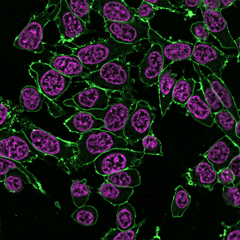The central dogma underlying spread of viral infections has relied on the belief that single, free-standing virus particles are the main agents responsible for viral transmission and infectivity. In a recent article in Cell Host & Microbe, Santiana et al., challenge this theory. They demonstrate that two gastroenteritic (stomach-flu) viruses, rotavirus and norovirus, are secreted by cultured cells and shed in stool as viral clusters enclosed within membrane derived vesicles. Vesicle-cloaked viral clusters form a significant fraction of the stool viral pool, remain intact during fecal-oral transmission, and are more virulent infectious agents than free viruses.
The authors use confocal imaging, immunostaining, electron microscopy and mass spectrometry to characterize the nature of the vesicle-cloaked viruses. Membrane selective CellBrite™ Fix 488 was used to demonstrate that multiple viruses were present inside membrane enclosed vesicles of plasma membrane or exosomal origin, depending on the viral strain. Labeling with CellBrite™ Fix 488 was also used to demonstrate uptake of the viral vesicles through the endocytic pathway, and to track their passage through the GI tract. Their findings pose intriguing questions about the lifecycle, benefits of multiplicity of infection (MOI), and transmission of enteric viruses in disease severity and suggest possible strategies for antiviral therapeutics that would disrupt virus-virus interactions or prevent clustering in vesicle membranes within cells.

Learn more about our CellBrite™ Fix and MemBrite™ Fix surface stains that tolerate fixation and permeabilization. Also view our wide selection of other cell surface stains include WGA and Con A lectin conjugates, original lipophilic CellBrite™ Cytoplamsic Membrane Dyes, and CellBrite™ Steady Membrane Staining Kits for long-term cell surface labeling.
Full Citation
Santiana, M., Ghosh, S., Ho, B. A., Rajasekaran, V., Du, W. L., Mutsafi, Y., … Altan-Bonnet, N. (2018). Vesicle-Cloaked Virus Clusters Are Optimal Units for Inter-organismal Viral Transmission. Cell Host and Microbe, 24(2), 208-220.e8. https://doi.org/10.1016/j.chom.2018.07.006

